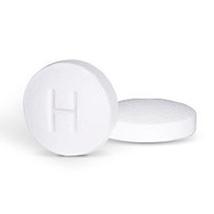Wakix Disease Interactions
There are 4 disease interactions with Wakix (pitolisant).
CNS stimulants (applies to Wakix) psychiatric disorders
Major Potential Hazard, Moderate plausibility. Applicable conditions: Psychosis, Depression
The use of CNS stimulants can cause psychotic symptoms, suicidal ideation, and aggression, and can exacerbate symptoms of behavior disturbance and thought disorder; CNS stimulants may induce a manic or mixed episode in patients with bipolar disorder. Psychiatric symptoms have been reported in patients with and without history of psychiatric disorders. All patients (particularly those with psychotic or bipolar disorders) should be monitored closely, especially during treatment initiation and at times of dose changes. Extreme caution should be exercised when CNS stimulants are given to patients with a history of psychosis, depression, mania, or bipolar disorder. Prior to initiating therapy, all patients should be screened for risk factors for developing a manic episode (e.g., comorbid or history of depressive symptoms or family history of suicide, bipolar disease, or depression). If any psychiatric symptoms emerge or are exacerbated, treatment suspension should be considered. Some CNS stimulants are contraindicated in patients with marked agitation or anxiety.
References
- (2001) "Product Information. Provigil (modafinil)." Cephalon, Inc
- (2001) "Product Information. Cylert (pemoline)." Abbott Pharmaceutical
- (2001) "Product Information. Ritalin (methylphenidate)." Novartis Pharmaceuticals
- (2001) "Product Information. Dopram (doxapram)." West Ward Pharmaceutical Corporation
- (2001) "Product Information. Dexedrine (dextroamphetamine)." SmithKline Beecham
- (2001) "Product Information. Adderall (amphetamine-dextroamphetamine)." Shire Richwood Pharmaceutical Company Inc
- (2001) "Product Information. Didrex (benzphetamine)." Pharmacia and Upjohn
- (2001) "Product Information. Prelu-2 (phendimetrazine)." Boehringer-Ingelheim
- (2001) "Product Information. Tenuate (diethylpropion)." Aventis Pharmaceuticals
- (2001) "Product Information. Sanorex (mazindol)." Novartis Pharmaceuticals
- (2001) "Product Information. Focalin (dexmethylphenidate)." Mikart Inc
- (2002) "Product Information. Concerta (methylphenidate)." Alza
- (2002) "Product Information. Strattera (atomoxetine)." Lilly, Eli and Company
- (2007) "Product Information. Vyvanse (lisdexamfetamine)." Shire US Inc
- (2007) "Product Information. Nuvigil (armodafinil)." Cephalon Inc
- (2012) "Product Information. Phendimetrazine Tartrate SR (phendimetrazine)." Sandoz Inc
- (2020) "Product Information. Fintepla (fenfluramine)." Zogenix, Inc
- (2023) "Product Information. Qsymia (phentermine-topiramate)." Vivus Inc, SUPPL-23
- (2019) "Product Information. Phentermine Hydrochloride (phentermine)." Tagi Pharma Inc
- (2023) "Product Information. Desoxyn (methamphetamine)." Recordati Rare Diseases Inc, SUPPL-38
Pitolisant (applies to Wakix) hepatic impairment
Major Potential Hazard, Moderate plausibility. Applicable conditions: Liver Disease
Pitolisant is contraindicated in patients with severe hepatic impairment. Pitolisant is extensively metabolized by the liver. Care should be exercised when using pitolisant in patients with moderate hepatic impairment. It is recommended to monitor patients with mild and moderate hepatic impairment and to adjust the dosage of pitolisant in patients with moderate hepatic impairment as appropriate. No dosage adjustment is recommended in patients with mild hepatic impairment.
References
- (2019) "Product Information. Wakix (pitolisant)." Harmony Biosciences, LLC
Pitolisant (applies to Wakix) arrhythmias
Moderate Potential Hazard, Moderate plausibility. Applicable conditions: Liver Disease, Renal Dysfunction, Hypokalemia, Magnesium Imbalance
Pitolisant prolongs the QT interval. The use of pitolisant should be avoided in patients with known QT prolongation or in combination with other drugs known to prolong the QT interval. The use of pitolisant should also be avoided in patients with a history of cardiac arrhythmias, as well as other circumstances that may increase the risk of the occurrence of torsade de pointes or sudden death, including symptomatic bradycardia, hypokalemia or hypomagnesemia, and the presence of congenital prolongation of the QT interval. The risk of QT prolongation may be greater in patients with hepatic or renal impairment due to higher concentrations of pitolisant. It is recommended to monitor patients with hepatic or renal impairment for increased QTc. Exercise care when using this agent in patients with these conditions.
References
- (2019) "Product Information. Wakix (pitolisant)." Harmony Biosciences, LLC
Pitolisant (applies to Wakix) renal disease
Moderate Potential Hazard, Moderate plausibility. Applicable conditions: Renal Dysfunction
The pharmacokinetics of pitolisant in patients with end-stage renal disease (ESRD) (eGFR of <15 mL/minute/1.73 m2) is unknown. Pitolisant is not recommended in patients with ESRD. It is recommended to adjust the dosage of pitolisant when using this agent in patients with moderate (eGFR 30 to 59 mL/minute/1.73 m2) and severe (eGFR 15 to 29 mL/minute/1.73 m2) renal impairment.
References
- (2019) "Product Information. Wakix (pitolisant)." Harmony Biosciences, LLC
Wakix drug interactions
There are 477 drug interactions with Wakix (pitolisant).
More about Wakix (pitolisant)
- Wakix consumer information
- Check interactions
- Compare alternatives
- Pricing & coupons
- Reviews (21)
- Drug images
- Side effects
- Dosage information
- During pregnancy
- FDA approval history
- Drug class: CNS stimulants
- Breastfeeding
- En español
Related treatment guides
Drug Interaction Classification
| Highly clinically significant. Avoid combinations; the risk of the interaction outweighs the benefit. | |
| Moderately clinically significant. Usually avoid combinations; use it only under special circumstances. | |
| Minimally clinically significant. Minimize risk; assess risk and consider an alternative drug, take steps to circumvent the interaction risk and/or institute a monitoring plan. | |
| No interaction information available. |
Further information
Always consult your healthcare provider to ensure the information displayed on this page applies to your personal circumstances.


